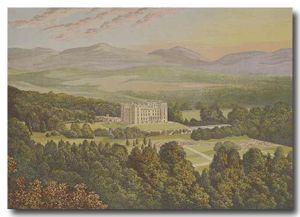 Drumlanrig castle can be found 3 miles North of Thornhill and ½ mile West of highway A76. It was built by William Douglas, 1st Duke of Queensberry, between 1679 and 1691. It is a magnificient pink sandstone Scottish Renaissance palace. It is actually a large palatial country house, rather than a castle. But it was built on the site of traditional Douglas strongholds. The architect was either James Smith or his father-in-law, Robert Mylne, the King's Master Mason, though earlier plans by William Wallace for a house resembling his Heriot's Hospital in Edinburgh may have provided the inspiration for the builders. The building is a rectangle, laid around the inner courtyard. Towers, Corinthian pilasters, horseshoe staircase, baroque frontispiece and ducal coronet are amoung a few of the interesting architectural show pieces. The magnificent Great Avenue leading up to the castle, provides a breath-taking view of the park like lands surrounding the castle.
Drumlanrig castle can be found 3 miles North of Thornhill and ½ mile West of highway A76. It was built by William Douglas, 1st Duke of Queensberry, between 1679 and 1691. It is a magnificient pink sandstone Scottish Renaissance palace. It is actually a large palatial country house, rather than a castle. But it was built on the site of traditional Douglas strongholds. The architect was either James Smith or his father-in-law, Robert Mylne, the King's Master Mason, though earlier plans by William Wallace for a house resembling his Heriot's Hospital in Edinburgh may have provided the inspiration for the builders. The building is a rectangle, laid around the inner courtyard. Towers, Corinthian pilasters, horseshoe staircase, baroque frontispiece and ducal coronet are amoung a few of the interesting architectural show pieces. The magnificent Great Avenue leading up to the castle, provides a breath-taking view of the park like lands surrounding the castle.
Inside, the entrance hall was originally an open loggia, but was glazed in in 1813. Fine wood carvings are found throughout the building. The oak panelled staircase hall is the site of the staircase gallery, with its 1680 heavy silver chandelier. The house also contains numerous priceless paintings, including ones by Rembrandt, Correggio, Murillo, Clouet, and portraits by Dahl, Kneller, Reynolds and Ramsey.
It should be noted that Drumlanrig Castle is open for tours, including land rover tours of the estate, but only during certain months of the year. In 2008, the estate is open to the public April though August. Check before you go. Land Rover tours need prior reservations.
See the related article on the Suicide of the Mouswald Heiress to review the Carruthers connection to Drumlanrig.



 Drumlanrig castle can be found 3 miles North of Thornhill and ½ mile West of highway A76. It was built by William Douglas, 1st Duke of Queensberry, between 1679 and 1691. It is a magnificient pink sandstone Scottish Renaissance palace. It is actually a large palatial country house, rather than a castle. But it was built on the site of traditional Douglas strongholds. The architect was either James Smith or his father-in-law, Robert Mylne, the King's Master Mason, though earlier plans by William Wallace for a house resembling his Heriot's Hospital in Edinburgh may have provided the inspiration for the builders. The building is a rectangle, laid around the inner courtyard. Towers, Corinthian pilasters, horseshoe staircase, baroque frontispiece and ducal coronet are amoung a few of the interesting architectural show pieces. The magnificent Great Avenue leading up to the castle, provides a breath-taking view of the park like lands surrounding the castle.
Drumlanrig castle can be found 3 miles North of Thornhill and ½ mile West of highway A76. It was built by William Douglas, 1st Duke of Queensberry, between 1679 and 1691. It is a magnificient pink sandstone Scottish Renaissance palace. It is actually a large palatial country house, rather than a castle. But it was built on the site of traditional Douglas strongholds. The architect was either James Smith or his father-in-law, Robert Mylne, the King's Master Mason, though earlier plans by William Wallace for a house resembling his Heriot's Hospital in Edinburgh may have provided the inspiration for the builders. The building is a rectangle, laid around the inner courtyard. Towers, Corinthian pilasters, horseshoe staircase, baroque frontispiece and ducal coronet are amoung a few of the interesting architectural show pieces. The magnificent Great Avenue leading up to the castle, provides a breath-taking view of the park like lands surrounding the castle.


